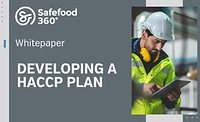Implementing a Paperless HACCP System

Food safety is an ongoing issue for any manufacturers who produce or package edible materials. As such food safety programs (FSP) must be developed to document a business’s practice of handling food. Hazard Analysis and Critical Control Points (HACCP) plans provide a systematic preventive for food safety planning and are encouraged within Australia to uphold and ensure correct practices. HACCP is also internationally recognized and often a requirement when importing or exporting food, beverages or raw material.
Food businesses should record and retain copies of action taken demonstrating compliance with the food safety program and ensure it is audited by a food safety auditor. Paperless software simplifies this process by providing automated and inspection processes, allowing employees to create routine checks of critical control points and identified potential hazards. Not only does this save time, energy and money it allows for employees to pre prepare and anticipate potential threats and create effective work routines and high-quality workplaces.
Seven-Stage HACCP Paperless System
1. Hazard Analysis: This stage can be completed by identifying any hazardous biological, chemical, or physical property in raw materials and processing steps, and to assess their likeliness of occurrence and potential to manufacture food unsafe for consumption. This stage can quickly be completed by photographing and annotating potential hazardous areas at all touch points raw materials coincide with.
2. Critical Control Points: An area which is controlled to prevent/eliminate the possibility of a hazard to occur. By referring to collected images and notes, a logical decision can be concluded whether preventative steps are needed to be introduced.
3. Critical Limits: This stage concludes an acceptable or unacceptable level of use i.e. temperature, humidity, water activity etc. Once evaluated appropriately, it can be noted for future use alongside the existing imagery. This imagery also acts as references for employees as they now have photographic evidence of what acceptable levels refer to.
4. Critical Control Monitoring: Through paperless software, it allows the ongoing input of data, both imagery, and notes in a logical, systematic order. This then allows business to review trends in data input which will act as warnings and highlight areas which need attention. This stage employees can input their name and time/date data was collected
5. Corrective Actions: Preventative procedures must be in place and developed so employees are able to intervene with different points, process and materials before it is able to affect the raw material. Employees may refer to procedure notes allocated through Pervidi to perform the corrective procedure correctly.
6. Evaluation Procedures: Testing is needed for the ongoing evaluation of the HACCP plan and its recognized procedures. Evaluation is made easy with paperless software as after the correct evaluation is assigned i.e. observation, levels, sampling etc. Employees can then simply input data via annotating imagery, uploading form and making notes.
7. Record Keeping: Detailed records are essential to creating accurate and useful data. These records encourage high-quality workspaces and correct process and are helpful for the documentation of the HACCP plan, tracing ingredients and different process points when problems occur and identifying both long- and short-term trends.
By combining the tools of mobile data collection and automation, a food inspector and the community can achieve a safer food future for all.
Gareth Higgins is the marketing manager at Pervidi, a leader in field inspection solution and offers clients a customized and automated solution for collecting data in the field using mobile devices. Established in 1999, Pervidi now has more than 10,000 users around the world using Pervidi paperless inspection solution to optimize productivity on a daily basis.
Looking for a reprint of this article?
From high-res PDFs to custom plaques, order your copy today!





